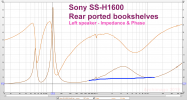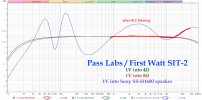- Joined
- Aug 14, 2018
- Messages
- 2,769
- Likes
- 8,146
What is difficult for me as a layman (without electronics background) is to reconcile such statements with the real measurements of other reviewers.
The differences are not extreme, but still clearly present. The speaker load that Archimago uses is challenging in the low frequency with up to just under 60 ohms, but around the typical crossover frequency to the tweeter with just over 15 ohms not challenging, up to30-60 ohms are quite realistic. In the range above 2 kHz, a speaker load of about 60 Ohm would lead to significantly larger deviations than in the review.
Looking at just the 4 and 8 ohm FR measurements, the amp is just acceptable to me, but with the speaker load, the frequency response deviation in the frequency range below 10kHz is too much for me. So for me as a layman, the speaker load provides additional information, because I could not have foreseen these deviations in the FR.
View attachment 282654

MEASUREMENTS: Fosi Audio TB10D [Upgraded Version] stereo amplifier (TI TPA3255 Class D). Ethernet is inherently "isolated".
A blog for audiophiles about more objective topics. Measurements of audio gear. Reasonable, realistic, no snakeoil assessment of sound, and equipment.archimago.blogspot.com
Speaker load:
View attachment 282655

The "Measurement Of Amplifiers Rig" (MOAR): Standard Tests, Loopback results, and the AMOAR Score.
A blog for audiophiles about more objective topics. Measurements of audio gear. Reasonable, realistic, no snakeoil assessment of sound, and equipment.archimago.blogspot.com
useful for Class-A amps too:
View attachment 282658

REVIEW / MEASUREMENTS: Pass Labs / First Watt SIT-2 stereo Class A amplifier. [And Stereophile steps in with MQA yet again...]
A blog for audiophiles about more objective topics. Measurements of audio gear. Reasonable, realistic, no snakeoil assessment of sound, and equipment.archimago.blogspot.com
Thanks for this - very interesting!
Again, I'm not an expert, but there is one point that I think is extremely important here: both of these amps are load-dependent amps, and we don't need the Sony speaker to reveal that.
The first one, the Fosi, is a TPA3255-based amp, and all (or at least the vast majority of) such amps are known to be load-dependent. It is very true, as @Holdt says, that there's no way we can predict the Fosi's frequency response curve into that Sony SS-H1600 (the blue line) by looking only at the Fosi's response with a 4 ohm or 8 ohm resistive load (the green and red lines).
But we don't need the Sony/blue line to tell us that the Fosi amp is load-dependent: the response starts dropping at 3kHz when feeding the amp into a simple resistive 4 ohm load, and it starts peaking at the same point with an 8 ohm load.
Now, I will certainly admit that with the Pass amp, the difference in response at 4 ohms vs 8 ohms is much more subtle. But (a) it is still there; (b) Pass says the amp is designed for 4-16 ohm loads so if that Sony speaker is really presenting 30-60 ohms then it's way outside the operating design of that amp; and (c) Pass's design uses no feedback and he says it uses a special transistor that "behaves like a triode" - in other words he says it basically behaves like a tube amp, and tube amps are known to be load-dependent.
So here is the issue that I'm having trouble understanding: once you know that an amp is load dependent, why would you consider buying or using that amp? Why do you need to know - or why is it useful to know - exactly how its frequency response looks with a particular speaker (like the Sony SS-H1600) when the chances of you ever using that speaker with that amp are virtually nil? In other words, isn't the diverging frequency response into 4 ohms vs 8 ohms sufficient to tell you that this amp's frequency response is not dependable with varying impedance, and so if that is a concern then you should not choose that amp?
I'm not trying to be snarky, rhetorical, or disrespectful here. And of course I have zero problem testing amps with complex loads for curiosity and interest. But I'm genuinely asking - what qualitatively different or new insight do we get by running an amp into a complex load like this? Thanks!





